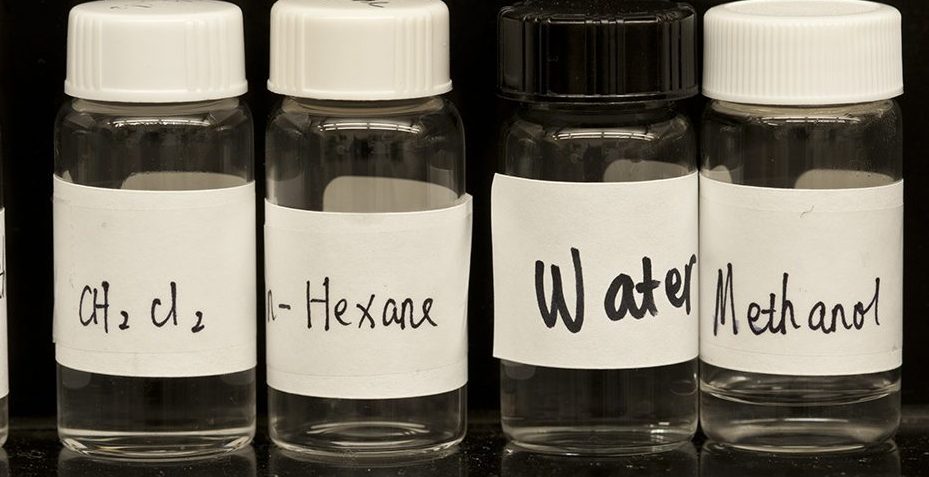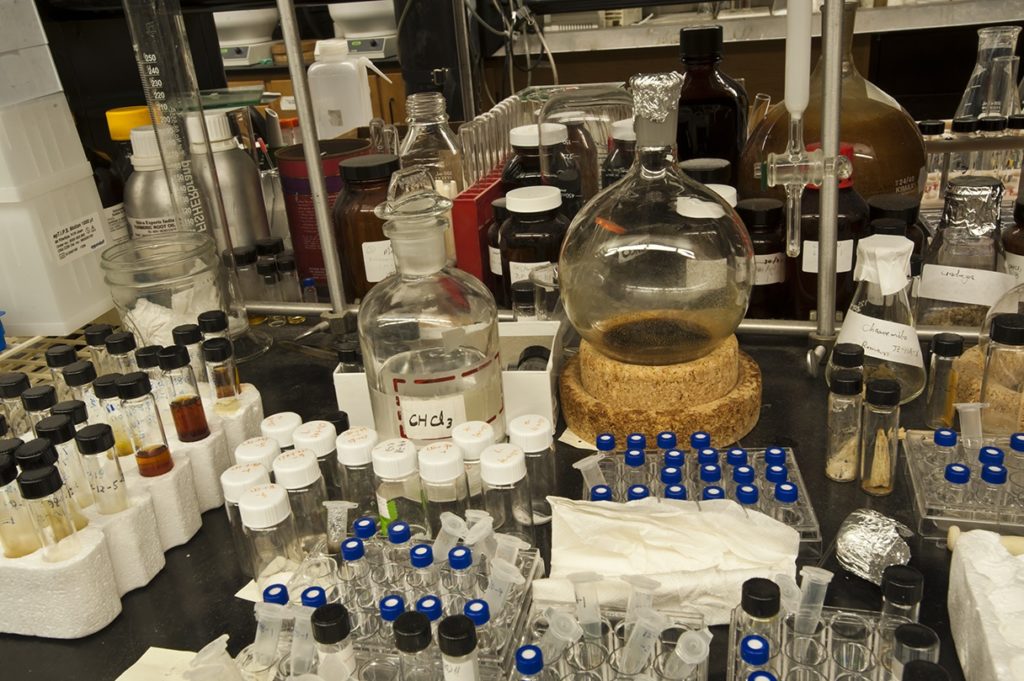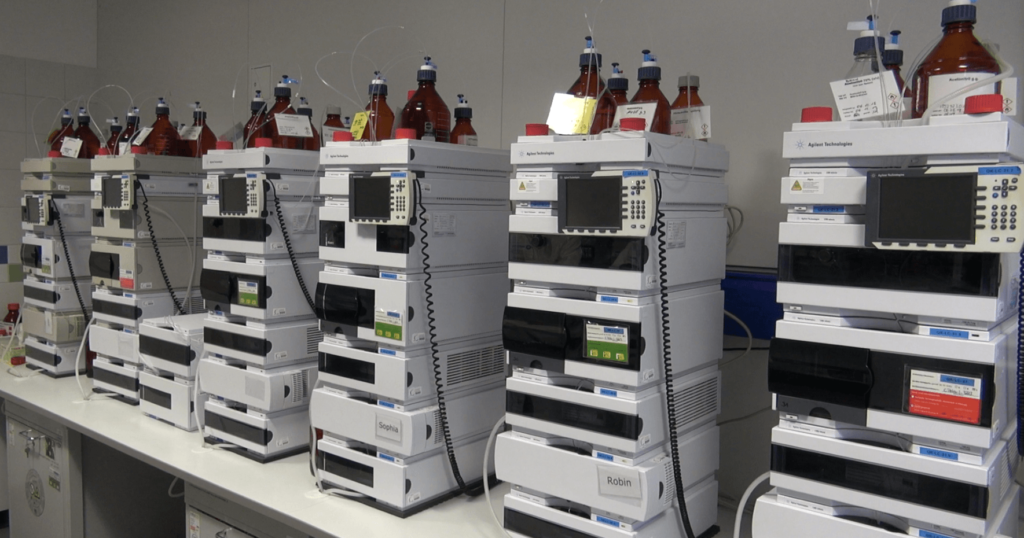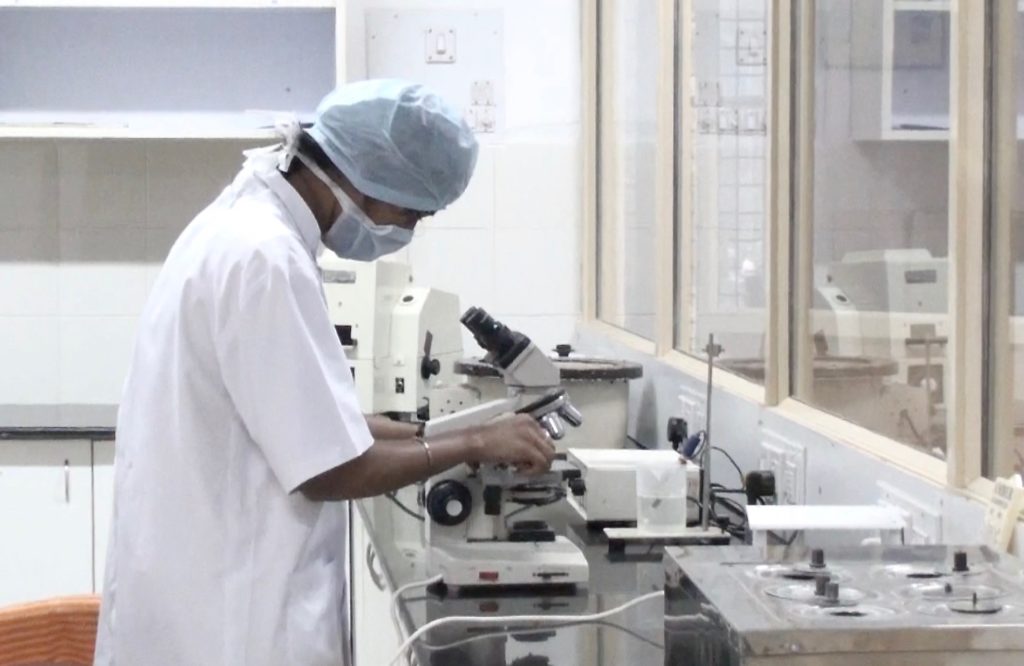How Green is your Laboratory?

By Stefan Gafner, Chief Scientific Officer, American Botanical Council
Please note: This page is not responsive. We are working to fix whatever is the problem. Our apologies for the inconvenience!
Environmental Footprint of Laboratories
While much of the debate surrounding sustainable practices[1] in the botanical dietary supplement industry revolves around growing and harvesting practices, the sustainability of production facilities, R&D and quality control laboratories is often overlooked. Reliable data on waste production in dietary supplement manufacturing laboratories are unavailable, but a 2015 estimate puts the global annual production of plastic waste in institutions performing biological, medical or agricultural research to ca. 5.5 million metric tons (around 2% of the global plastic waste produced).[2] A Bloomberg New report from 2008 states that 100 billion pairs of medical gloves are thrown away each year.[3] Other major contributors to the plastic waste stream are pipette tips, bottles, petri dishes, and autosampler vials. At the same time, laboratories use 5-10 times more energy per square foot than office buildings.[4,5]

Lab Equipment and Laboratories at the National Center for Natural Products Research, University of Mississippi. Photo by Steven Foster.
However, sustainability is often not the top priority when selecting a manufacturing process, or a new laboratory test method. The manufacturing process must be cost-efficient; ingredients are often sourced primarily based on price and volume capacities of the supplier, and chemical and microbiological test methods must comply with accepted performance criteria.
Reduce, Reuse, Recycle
Nevertheless, the principles “reduce, reuse, recycle” can and should be applied in the R&D, manufacturing and quality control environments. Many laboratories have made efforts to improve their environmental fingerprint, e.g., by building LEED-certified facilities, installing motion-sensitive lighting equipment, implementing state-of-the art recycling options, or reducing the amount of chemicals used, for example through miniaturization, or by measuring analytes in situ. A 2019 Chemical and Engineering News article[6] suggests the following:
Reduce:
- Switch from disposable to reusable whenever possible
- Avoid packaging waste
- Buy the lowest amount/volume necessary
Reuse:
- Use packaging and bottles for other purpose
- Consider washing and reusing so-called “single-use” consumables if the environmental burdens of washing are less than those of recycling or disposal and replacement
Recycle:
- Look for suppliers or organizations that recycle laboratory waste such as plastics and gloves
- Decontaminate used labware so it can be recycled (labels on bottles of hazardous solvents may need to be removed after decontamination prior to recycling)
Energy Consumption of Labs
When it comes to energy consumption, low-temperature freezers, fume hoods, and autoclaves are among the most energy-intensive equipments.[7-9] But any instrument that involves heating or cooling will draw a substantial amount of energy. Common-sense methods to reduce the energy consumption in laboratories include to shut off equipment when not in use (the use of timers may be helpful), increase the temperature of freezers when possible, consolidate materials in freezers/incubators, share equipment, and wait to sterilize equipment in an autoclave until it is filled up.
Tips on how to reduce energy consumption have been published e.g., by Stanford University,[10] Princeton University,[11] North Carolina State University,[12] and Drahl.[13] A more complete discussion of strategies to reduce energy consumption in laboratories and office buildings has been published by Hafer.[9]
Testing Methods in Laboratories
Since I am most familiar with analytical laboratories, this article will discuss sustainability issues in this area. The same principles to improve sustainability in the analytical environment as in other laboratories are valid: (i) replace toxic reagents, (ii) reduce or eliminate the amounts of reagents and solvents employed, (iii) reduce the energy consumed, and (iv) avoid or minimize the volume of waste. However, when choosing a method, method performance parameters (accuracy, precision, selectivity, robustness, etc.), costs, and personnel use usually take precedence over environmental considerations. See Solvents and Green Chemistry for more information.
Attempts to reduce the sampling error may prompt an analyst to lean towards larger quantities and solvent volumes in the sample preparation process. In addition to the sample preparation steps, large volumes of solvent waste are especially common in liquid chromatography techniques, which are popular choices for analytical methods in the botanical dietary supplement industry due to the complexity of the samples.
On the positive side, the development of ultra-high-performance liquid chromatography (UHPLC) instruments allows shorter run times, lower flow rates, and smaller sample volumes to be used. Regarding sample preparation, technologies like headspace solid-phase microextraction (SPME) for gas chromatography (GC), or direct analysis in real time (DART) mass spectrometry (MS) allow the qualitative analysis of samples without prior dissolution. Infrared (IR) and near-infrared (NIR) are touted as green alternatives to liquid chromatographic methods. But how do we know if these methods are in fact “greener”,[14] i.e., use lower solvent amounts and less toxic solvents, use in situ methods (no derivatization), consume less energy, and produce less waste?
Is it Green?
There are a few methods that are available to measure the “greenness” of an analytical method. One of the first approaches to measure the environmental impact was published on the National Environmental Methods Index (NEMI) website,[15,16] but it is unclear if the tool is still available. NEMI assesses four impact categories: (i) the reagents environmental persistence, accumulation and toxicity, (ii) it’s health hazard, (iii) the corrosivity, and (iv) the amount of solvent waste created. It does not factor plastic and glassware waste, and energy consumption of the method.
A more comprehensive approach is the analytical eco-scale, initially published by Gałuszka et al.[14] The eco-scale factors in the amount(s) of solvent used and its health and environmental hazard, the energy consumed during analysis, the amount of solvent waste, and the occupational hazard created during the analysis. The system works like the penalty point or demerit point system where drivers in certain countries or the U.S. are given penalty points for road traffic offenses. A few additional points, e.g., waste from consumables and a life-cycle analysis of the analytical instrument are not included in the eco-scale, but it may nevertheless be a worthy exercise to compare the eco-scale numbers of two compendial methods, i.e., the United States Pharmacopeial (USP) high-performance thin-layer chromatography (HPTLC) and high-performance liquid chromatography (HPLC) methods for powdered turmeric (Curcuma longa, Zingiberaceae) rhizome extracts (solvents and their volumes used are listed in Table 1).[17]
Table 1: Type and amounts of solvents and reagents used in the USP HPTLC and HPLC methods for powdered turmeric extract
|
|
HPTLCa
|
HPLC
|
| Sample preparation solvent (mL)
|
Methanol (10 mL)
|
Acetone (50 mL)
Tetrahydrofuran (18 mL) Water (27 mL) Citric acid (45 mg) |
| Mobile phase (mL) | Toluene (8 mL)
Glacial acetic acid (2 mL)
|
Tetrahydrofuran (14 mL)
Water (21 mL) Citric acid (35 mg) |
| Detection reagent (mL) | Methanol (8.5 mL)
Glacial acetic acid (1 mL) Sulfuric acid conc. (0.5 mL) p-Anisaldehyde (0.05 mL) |
aThe solvent volumes are not specified; calculations are based on assumptions of 10 mL for sample preparation, mobile phase, and detection reagent.
The eco-scale starts with a total of 100 points. The higher the sustainability impact, the more points are subtracted. The solvent penalty is the product of solvent volume (1 for less than 10 mL, 2 for volumes of 10-100 mL, and 3 for volumes above 100 mL) multiplied by the solvent’s environmental impact (Table 2).[14,18] The environmental impact is calculated by the number of warning and danger signs on the solvent label (available on the safety data sheet, SDS).[18]
Table 2: Penalty points for solvents used in the USP HPTLC and HPLC methods for powdered turmeric extract
| Solvent
|
SDS Hazard Penalty
|
Penalty Points HPTLC
|
Penalty Points HPLC
|
| Acetic acid
Acetone p-Anisaldehyde Citric acid Methanol Sulfuric acid Tetrahydrofuran Toluene Water |
4
4 0 1 6 4 6 6 0 |
4
0 0 0 12 4 0 6 0 |
0
8 0 1 0 0 12 0 0 |
|
Total |
|
26 |
21 |
If the sample preparation and analysis are carried out without the production of toxic vapors in the atmosphere, no additional points for being an occupational hazard are subtracted for both methods. However, the energy consumption for HPTLC (< 0.1 kWh, 1 penalty point) and HPLC (< 1.5 kWh, 2 penalty points) per sample[19] needs to be factored in, and finally the amounts of solvent waste and solvent disposal options will also be considered according to Tobiszewski et al.[18]
Based on all the available information, the calculated eco-scale score is 65 for the HPTLC and 69 for the HPLC method, respectively, after subtracting the penalty points (Table 3) from the initial value of 100. This suggests that the HPLC method may have a slightly better environmental fingerprint despite the larger solvent volume needed to perform the analysis.
Table 3: Eco-scale penalty points for the USP HPTLC and HPLC methods for powdered turmeric extract
| Parameter
|
HPTLC
|
HPLC
|
| Solvent type and volume
Energy consumption Occupational hazard Solvent waste volume Solvent incineration |
26
1 0 5 3 |
21
2 0 5 3 |
|
Total penalty points |
35 |
31 |
Particularly solvent-intense is the isolation of reference standards from natural sources. For example, the isolation of ca. 45 mg of licoricidin from a licorice (Glycyrrhiza uralensis, Fabaceae) extract required over 9 liters of acetonitrile (S. Gafner, unpublished results). While some reference compounds may be obtained in a more environmentally-friendly manner by chemical synthesis, commercial standards are unavailable for many of the components in botanical ingredients. In these cases, isolating them using the plant as source material may be the only option. Using a more sustainable approach to obtain reference compounds is feasible, as shown by the example by Shen et al.[20] who replaced a methanol-tetrahydrofuran-water mixture with the less toxic solvents ethanol, ethyl acetate, and water to obtain ginkgo terpene lactones from a ginkgo (Ginkgo biloba, Ginkgoaceae) extract.
Waste Disposal
Laboratory waste disposal can be expensive. Therefore reducing and reusing materials is not only the most sustainable, but also an economical practice. Obviously, there is no manufacturing plant or scientific laboratory that does not create any waste. And so it is important to keep the waste streams separate to allow for an appropriate disposal.[21]
The management of solid and liquid chemical waste is usually done by a contractor. Certain nonhazardous chemicals (potassium chloride, sodium carbonate, glucose, fructose, etc.) may be disposed of in the normal trash,[21] but most reagents will need to be collected and disposed of by a waste management company. Surplus chemical programs can be a good way at universities or in large industry settings to reuse chemicals.[22] Some solvents can be re-used after distillation (minimizing the use of halogenated solvents or collecting them separately aids recovery of other solvents), e.g., ethanol used for extraction of botanical materials can be re-distilled and then used to clean glassware. Local, state, or federal permits may be necessary to do so.
Glass is a particularly attractive material for re-use in a laboratory. Laboratory glassware is often designed for long-term use, although solvent/reagent bottles, autosampler vials, glass pipets, etc. are most often discarded. However, pipets or vials for use with ethanol, methanol, acetone, or other volatile solvents may be re-purposed. For solvent or reagent bottles made of glass, triple rinsing is required in order to decontaminate the bottle.[21] In addition, the label may need to be removed as the local recycling program may hesitate to pick up a bottle labeled to contain concentrated hydrochloric acid, even if it has been properly cleaned.
Certain organic waste (e.g., unused plant material) are suitable for composting, although regulations may require a certain distance between a manufacturing plant, or a scientific laboratory, and the composting bin in order to avoid attracting rodents.
What You Can Do
Each effort to improve the environmental fingerprint of your company is a step in the right direction. Many responsible companies have initiated programs to making their production, testing, and innovation more sustainable. What can you do? Below are some additional resources of information to make a laboratory “greener”:
https://osha.washington.edu/pages/green-labs-webinar
https://greenchemistry.yale.edu/
References
- Defined in the Brundtland report as practices “that meet the needs of the present without compromising the ability of future generations to meet their own needs*,”Report of the World Commission on Environment and Development: Our Common Future. Geneva, Switzerland: UN World Commission on Environment and Development; 1987.
- Urbina MA, Watts AJR, Reardon EE. Labs should cut plastic waste too. Nature 2015;528(7583):479.
- Scott M. Saving the world one glove at a time. Bloomberg.com [online]. June 12, 2008.
- Wesolowski DE, Olivetti E, Graham AC, et al. The use of feedback in lab energy conservation: fume hoods at MIT. Int J Sust High Educ. 2010;11(3):217-235.
- Laboratories for the 21st Century: An Introduction to low–energy design. In: U.S. Environmental Protection Agency and U.S. Department of Energy Office of Federal Energy Management Programs, ed. Golden, CO: National Renewable Energy Laboratory; 2008.
- Howes L. Can laboratories move away from single-use plastic? Chemical & Engineering News. 2019;97(43):22.
- Energy consumption of laboratory equipment. UC Santa Cruz. https://sustainability.ucsc.edu/engage/green-certified/green-labs/Energy%20Efficiency/energy_consumption.pdf.
- Norberg A. How much does that lab equipment consume anyways? International Institute for Sustainable Laboratories Annual Conference; September 24-26, 2013; Minneapolis, MN.
- Hafer M. Quantity and electricity consumption of plug load equipment on a university campus. Energy Efficiency. 2017;10(4):1013-1039.
- Craig C, Ahmed F. Save energy in laboratories. https://sustainable.stanford.edu/sites/default/files/HowTo_SaveEnergyInLabs.pdf. Accessed December 5, 2019.
- Greening up the lab: Sustainable research practices. 2018; https://ehs.princeton.edu/news/greening-the-lab-sustainable-research. Accessed December 12, 2019.
- Davis C. Saving energy in labs looks like this. 2015; https://sustainability.ncsu.edu/blog/changeyourstate/save-energy-in-lab/. Accessed December 5, 2019.
- Drahl C. To find hacks for greening your lab, start with the freezer. Chemical & Engineering News. 2018;96(35):20.
- Gałuszka A, Konieczka P, Migaszewski ZM, Namieśnik J. Analytical eco-scale for assessing the greenness of analytical procedures. TrAC Trends in Analytical Chemistry. 2012;37:61-72.
- Tobiszewski M. Metrics for green analytical chemistry. Anal Meth. 2016;8(15):2993-2999.
- Gilbert-López B, Mendiola JA, Ibáñez E. Green foodomics. Towards a cleaner scientific discipline. TrAC Trends in Analytical Chemistry. 2017;96:31-41.
- United States Pharmacopeia. Powdered turmeric extract. USP 42-NF 37. Rockville, MD: United States Pharmacopeial Convention; 2019:5258.
- Tobiszewski M, Marć M, Gałuszka A, Namieśnik J. Green chemistry metrics with special reference to green analytical chemistry. Molecules. 2015;20(6):10928-10946.
- Koel M, Kaljurand M. Greening sample treatment. Green Chemistry. 2 ed. Croydon, United Kingdom: Royal Society of Chemistry; 2019:87-167.
- Shen Y, Chen B, van Beek TA. Alternative solvents can make preparative liquid chromatography greener. Green Chem. 2015;17(7):4073-4081.
- National Research Council. Management of waste. Prudent Practices in the Laboratory: Handling and Management of Chemical Hazards. Washington, DC: The National Academies Press; 2011:183-210.
- Lab waste mangement. 2019; https://www.sustainability.ucsb.edu/lab-waste-management/. Accessed December 12, 2019.




Comments